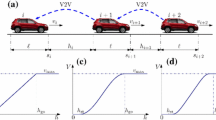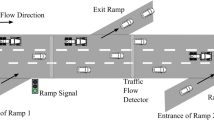Abstract
In this paper we propose a novel technique to decompose networked systems and use this technique to investigate the dynamics of connected vehicle networks with wireless vehicle-to-vehicle (V2V) communication. We apply modal perturbation analysis to approximate the modes of the perturbed network about the modes of the corresponding cyclically symmetric network. By exploiting the cyclic symmetry, we approximate the dynamics of a given mode by solving a small number of linear algebraic equations. We apply this approach to decompose connected vehicle networks into traveling waves which allows us to assess the impacts of long-range V2V communication on the stability of traffic flow.






Similar content being viewed by others
References
Alam, A., Mårtensson, J., Johansson, K.H.: Experimental evaluation of decentralized cooperative cruise control for heavy-duty vehicle platooning. Control Eng. Pract. 38, 11–25 (2015)
Alam, A., Besselink, B., Turri, V., Martensson, J., Johansson, K.H.: Heavy-duty vehicle platooning for sustainable freight transportation: a cooperative method to enhance safety and efficiency. IEEE Control Syst. 35(6), 34–56 (2015)
Avedisov, S.S., Orosz, G.: Nonlinear network modes in cyclic systems with applications to connected vehicles. J. Nonlinear Sci. 25(4), 1015–1049 (2015)
di Bernardo, M., Salvi, A., Santini, S.: Distributed consensus strategy for platooning of vehicles in the presence of time-varying heterogeneous communication delays. IEEE Trans. Intell. Transp. Syst. 16(1), 102–112 (2015)
Gallagher, B., Akatsuka, H., Suzuki, H.: Wireless communications for vehicle safety: radio link performance and wireless connectivity methods. IEEE Veh. Technol. Mag. 1(4), 4–24 (2006)
Ge, J.I., Avedisov, S.S., Orosz, G.: Stability of connected vehicle platoons with delayed acceleration feedback. In: Proceedings of the ASME Dynamical Systems and Control Conference. ASME (2013). Paper no. DSCC2013-4040
Ge, J.I., Orosz, G.: Dynamics of connected vehicle systems with delayed acceleration feedback. Transp. Res. Part C Emerg. Technol. 46, 46–64 (2014)
Ge, J.I., Orosz, G., Hajdu, D., Insperger, T., Moehlis, J.: To delay or not to delay—stability of connected cruise control time delay systems. Theory, numerics, applications, and experiments. In: Insperger, T., Ersal, T., Orosz, G. (eds.) Advances in Delays and Dynamics, vol. 7, pp. 263–282. Springer, Berlin (2017)
Ge, J.I., Orosz, G.: Optimal control of connected vehicle systems with communication delay and driver reaction time. IEEE Trans. Intell. Transp. Syst. (2016). doi:10.1109/TITS.2016.2633164
Geiger, A., Lauer, M., Moosmann, F., Ranft, B., Rapp, H., Stiller, C., Ziegler, J.: Team Annieway’s entry to the 2011 grand cooperative driving challenge. IEEE Trans. Intell. Transp. Syst. 13(3), 1008–1017 (2012)
Happawana, G.S., Nwokah, O.D.I., Bajaj, A.K., Azene, M.: Free and forced response of mistuned linear cyclic systems: a singular perturbation approach. J. Sound Vib. 211(5), 761–789 (1998)
Liu, Z.H., Liu, W., Gao, W.C., Cheng, X.: Advances of research on mode localization in mistuned cyclically periodic structures. Appl. Mech. Mater. 405–408, 3198–3203 (2013)
Lu, X.Y., Hedrick, J.K., Drew, M.: ACC/CACC-control design, stability and robust performance. In: Proceedings of the American Control Conference, vol. 6, pp. 4327–4332. IEEE (2002)
Liao, Y., Li, S.E., Wang, W., Wang, Y., Li, G., Cheng, B.: Detection of driver cognitive distraction: a comparison study of stop-controlled intersection and speed-limited highway. IEEE Trans. Intell. Transp. Syst. 17(6), 1628–1637 (2016)
Mangel, T., Michl, M., Klemp, O., Hartenstein, H.: Real-world measurements of non-line-of-sight reception quality for 5.9 GHz IEEE 802.11p at intersections. In: Strang, T., Festag, A., Vinel, A., Mehmood, R., Rico Garcia, C., Röckl, M. (eds.) Communication Technologies for Vehicles, pp. 189–202. Springer, Berlin (2011)
Milanés, V., Shladover, S.E.: Modeling cooperative and autonomous adaptive cruise control dynamic responses using experimental data. Transp. Res. Part C Emerg. Technol. 48, 285–300 (2014)
Milanés, V., Shladover, S.E., Spring, J., Nowakowski, C., Kawazoe, H., Nakamura, M.: Cooperative adaptive cruise control in real traffic situations. IEEE Trans. Intell. Transp. Syst. 15(1), 296–305 (2014)
Olson, B.J., Shaw, S.W., Shi, C., Pierre, C., Parker, R.G.: Circulant matrices and their application to vibration analysis. Appl. Mech. Rev. 66(4), 040803 (2014)
Öncü, S., Ploeg, J., van de Wouw, N., Nijmeijer, H.: Cooperative adaptive cruise control: network-aware analysis of string stability. IEEE Trans. Intell. Transp. Syst. 15(4), 1527–1537 (2014)
Orosz, G., Stépán, G.: Subcritical Hopf bifurcations in a car-following model with reaction-time delay. Proc. R. Soc. 462(2073), 2643–2670 (2006)
Orosz, G.: Connected cruise control: modelling, delay effects, and nonlinear behaviour. Veh. Syst. Dyn. 54(8), 1147–1176 (2016)
Pierre, C., Dowell, E.H.: Localization of vibrations by structural irregularity. J. Sound Vib. 114(3), 549–564 (1987)
Ploeg, J., van de Wouw, N., Nijmeijer, H.: Lp string stability of cascaded systems: application to vehicle platooning. IEEE Trans. Control Syst. Technol. 22(2), 1527–1537 (2014)
Qin, W.B., Gomez, M.M., Orosz, G.: Stability and frequency response under stochastic communication delays with applications to connected cruise design. IEEE Trans. Intell. Transp. Syst. 18(2), 388–403 (2017)
Rajamani, R.: Vehicle Dynamics and Control. Springer, Berlin (2011)
Roose, D., Szalai, R.: Continuation and bifurcation analysis of delay differential equations. In: Krauskopf, B., Osinga, H.M., Galan-Vioque, J. (eds.) Numerical Continuation Methods for Dynamical Systems, Understanding Complex Systems, pp. 359–399. Springer, Berlin (2007)
Shladover, S.E., Nowakowski, C., Lu, X.Y., Ferlis, R.: Cooperative adaptive cruise control (CACC) definitions and operating concepts. In: Proceedings of the 94th Annual TRB Meeting, 15-3265 (2015)
Shladover, S.E., Su, D., Lu, X.Y.: Impacts of cooperative adaptive cruise control on freeway traffic flow. Transp. Res. Rec. J. Transp. Res. Board 2324, 63–70 (2012)
Szalai, R., Orosz, G.: Decomposing the dynamics of heterogeneous delayed networks with applications to connected vehicle systems. Phys. Rev. E 88(4), 040902 (2013)
Wei, S.T., Pierre, C.: Localization phenomena in mistuned assemblies with cyclic symmetry part i: free vibrations. J. Vib. Acoust. Stress Reliab. Des. 110(4), 429–438 (1988)
Wang, M., Daamen, W., Hoogendoorn, S.P., van Arem, B.: Cooperative car-following control: distributed algorithm and impact on moving jam features. IEEE Trans. Intell. Transp. Syst. 17(5), 1459–1471 (2016)
Zhang, L., Orosz, G.: Motif-based design for connected vehicle systems in presence of heterogeneous connectivity structures and time delays. IEEE Trans. Intell. Transp. Syst. 17(6), 1638–1651 (2016)
Acknowledgements
Funding was provided by the National Science Foundation (Award No. 1351456).
Author information
Authors and Affiliations
Corresponding author
Appendices
Appendix 1: Third-order approximation of modal dynamics
To obtain the third-order perturbation of the dynamics of the k-th mode \([\hat{\mathbf {D}}^{(1,2,3)}]^{k}_{k}\) for an arbitrary \(i_{1},\sigma _{1},i_{2},\sigma _{2},i_{3},\sigma _{3}\) sextuple we take the derivative of (49) with respect to \(\varepsilon _{i_{3}\sigma _{3}}\) (denoted by \(\varepsilon _{3}\)) which yields
At \(\varepsilon _{i_{1}\sigma _{1}}=\varepsilon _{i_{2}\sigma _{2}}=\varepsilon _{i_{3}\sigma _{3}}=0\) we obtain
We can eliminate the last term in the expression above by multiplying by \([\hat{\mathbf {T}}_{0}^{-1}]^{k}\) from the left and using (26). Also because the above expression has six unknowns \(\Big (\) the \([\hat{\mathbf {D}}^{(\cdot ,\cdot ,\cdot )}]^{k}_{k}\)’s \(\Big )\) for each \(i_{1},\,\sigma _{1},\,i_{2},\,\sigma _{2},\,i_{3},\,\sigma _{3}\) sextuple we have the freedom to set
while the equations for the other third-order terms can be obtained by permuting on the indices corresponding to \(i_{1},\,\sigma _{1},\,i_{2},\,\sigma _{2},\,i_{3},\,\sigma _{3}\) on the left and right hand side of (91). By algebraic manipulation one can show \([\hat{\mathbf {T}}^{-1}_{0}]^{k}(\mathbf {I}_{N}\otimes [\hat{\mathbf {D}}^{(1,2)}]^{k}_{k})\hat{\mathbf {T}}_{0}[\hat{\mathbf {U}}^{(3)}]_{k}=[\hat{\mathbf {T}}^{-1}_{0}]^{k}(\mathbf {I}_{N}\otimes [\hat{\mathbf {D}}^{(1)}]^{k}_{k})\hat{\mathbf {T}}_{0}[\hat{\mathbf {U}}^{(2,3)}]_{k}=0\). This means we can simplify (91) to
and by using (17) we can obtain (62).
Appendix 2: Second-order approximation of the modal block eigenvector
Solving (59) for the connected vehicle network , we obtain the \((k,\ell )\)-th block of \(\hat{\mathbf {U}}^{(1,2)}\) whose elements are contained in
For \(k\ne \ell \) using (80,81) we obtain
where
and \(u^{(1)}_{k\ell ,12},\,u^{(2)}_{j\ell ,21},\,u^{(1)}_{k\ell ,22},\,u^{(2)}_{j\ell ,22}\) are given in (77). For the case \(k=\ell \) (59) has multiple possible solutions due to a nonzero nullity. In this case, we set
Appendix 3: Cubic terms of the modal approximation
The coefficients in (82) and (83) are given by
Appendix 4: Coefficients for modal stability boundaries and modal frequencies
The coefficients for \(p_{k}\) and \(\omega _{k}\) in (85) and (86) are obtained by plugging in (85) and (86) into (84) with \(p=p_{k}\) and \(\lambda =i\omega _{k}\). The zeroth-order terms in (85) and (86) are then determined by setting all \(\beta _{i\sigma }=0\), taking the real and imaginary parts of (84), and solving the resulting two equations for \(p_{k0}\) and \(\omega _{k0}\) we obtain
where \(\theta _{k}=\frac{2\pi }{N}(k-1)\). These expressions indeed correspond to (72) and (73).
To obtain the first-order terms for indices \(i_{1},\sigma _{1}\), we take the partial derivative of (84) with respect to \(\beta _{i_{1}\sigma _{1}}\) and evaluate the expression at \(\beta _{i_{1}\sigma _{1}}=0\). Then taking the real and imaginary parts, and performing some algebraic manipulation we get
Similarly, the second-order terms for the indices \(i_{1},\sigma _{1},i_{2},\sigma _{2}\) can be obtained by taking the second partial derivative of (84) with respect to \(\beta _{i_{1}\sigma _{1}}\) and \(\beta _{i_{2}\sigma _{2}}\) and evaluating the results at \(\beta _{i_{1}\sigma _{1}}=\beta _{i_{2}\sigma _{2}}=0\). Splitting the real and imaginary parts we obtain
where “\(|_{\mathrm {c}}\)” indicates that the quantity is evaluated with all \(\beta _{i\sigma }=0\).
Finally, to obtain the third-order terms for the indices \(i_{1},\sigma _{1},i_{2},\sigma _{2},i_{3},\sigma _{3}\) we take the third partial derivative of (84) with respect to \(\beta _{i_{1}\sigma _{1}}\), \(\beta _{i_{2}\sigma _{2}}\), and \(\beta _{i_{3}\sigma _{3}}\) and evaluate the result at \(\beta _{i_{1}\sigma _{1}}=\beta _{i_{2}\sigma _{2}}=\beta _{i_{3}\sigma _{3}}=0\). Taking the real and imaginary parts yields
Rights and permissions
About this article
Cite this article
Avedisov, S.S., Orosz, G. Analysis of connected vehicle networks using network-based perturbation techniques. Nonlinear Dyn 89, 1651–1672 (2017). https://doi.org/10.1007/s11071-017-3541-y
Received:
Accepted:
Published:
Issue Date:
DOI: https://doi.org/10.1007/s11071-017-3541-y




